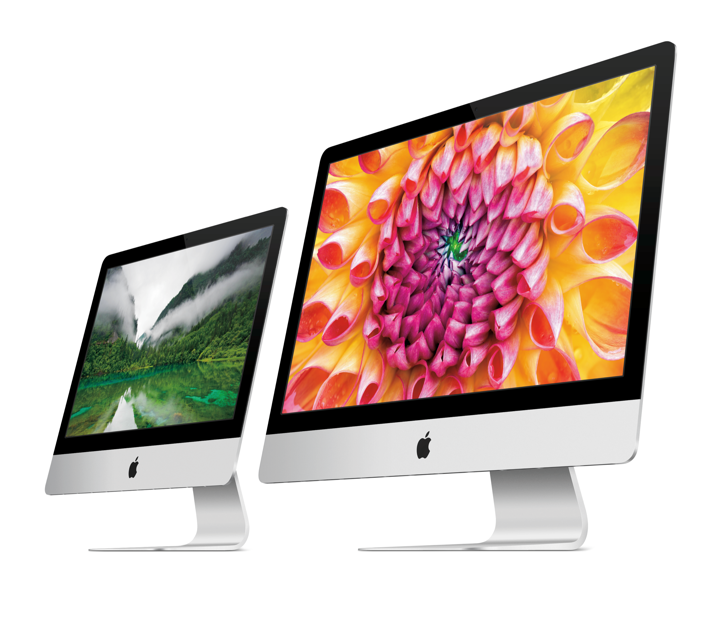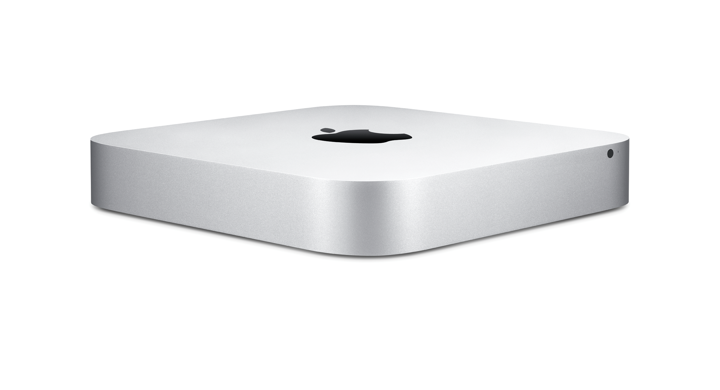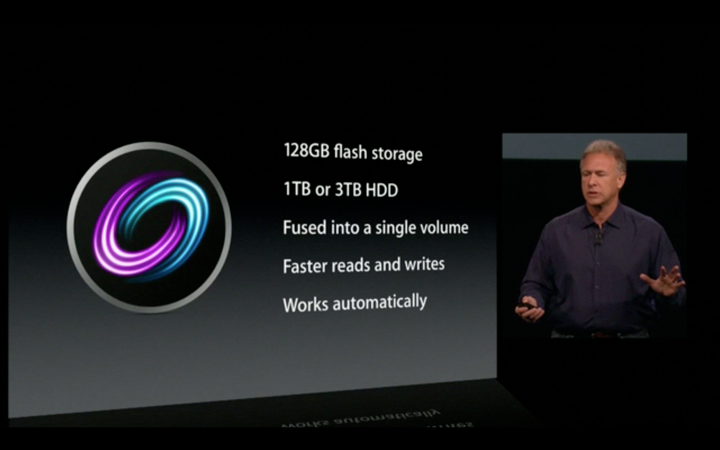
|
By Graham K. Rogers

You would think Apple would learn. After all these years of flagging sales, and with everyone looking forward to the rumoured new iPad mini, the main thrust of the announcements at the San José event was on Macs, with bottom feeder items like the Mac mini and the the MacBook Pro being tweaked, while the long-running iMac had another reprieve.
Unlike those lucky ones who are invited to the events, these days I receive my news from the events second hand these days: no more expenses paid trips for me to San Francisco. Am I jealous: stupid question. Of course I am. Fortunately Apple did provide a live feed for this event which I ran through before breakfast. While I was putting the finishing touch to some early impressions with the regular Cassandra column, a video podcast of the proceedings also downloaded, so I was able to share some of the points in class. More on that below.
Tim Cook, who dared to wear a blue shirt and black pants instead of the black shirt and jeans combo that is normally de rigueur at such events, looks more confident these days. He opened with some background, beginning with the disappointing iPhone 5, with the new A6 chip, that was released at another Apple event about 6 weeks ago, but only sold some 5 million in the first weekend, disappointing many analysts: "The most iPhones ever sold in the opening weekend, and the most phones ever sold in an opening weekend." Clearly Apple must do better.
Cook ran offstage to play a staged video which showed first buyers in places like Hong Kong, London, New York, somewhere in Germany and customers in other countries. Quite why a dog would line up for an iPhone 5 is beyond me.
Returning to the stage, Cook reminded us of the recently updated iPods that have only sold 3 million units. Rushing on to avoid the embarrassment of Maps, Cook mentioned that only 200 million devices were running iOS 6. With a mention of apps and the App Store, Cook focussed on an update to iBooks. Before he could do too much damage, he handed over to Phil Schiller.
Let's get real. Although at least one commentator rolled out (trolled out) the "Apple is finished" mantra as he did a few months ago (my thanks to Mac Daily News for the heads-up), the wide range of products released showed that Apple still has the edge over any other manufacturer in the industry and is still innovating.
That is dismissed by those pundits who only examine the shiny surfaces, the price tags, then run to compare with the opposition. Opposition? By using such terms, or intimating that Cupertino is in some form of competition, the writers demonstrate instantly that they do not have any real grasp on what Apple is, or does.
Cook is CEO and understands his limitations as presenter. Apple has plenty of other VPs who are up to the task, like Ferlinghetti and Forestall, as well as a good support team. Jony Ive and Bob Mansfield, both come to mind here, but they are less comfortable with the presentation medium and prefer to be seen in videos. Ive was at his most intense with one shown at the Event later in the proceedings, showing how well (with advertisements at the ready as well) Apple is prepared.
Phil Schiller takes the reins for product presentations because he does the job well. He knows the product inside out by the time he steps up on the stage. There are no histrionics, or prancing about likewe saw with Johnny Shih's embarrassing presentation of the Pad-phone.
Schiller had five products to introduce and started with the Macs:
- 13" MacBook Pro with Retina display
The range of notebooks computers has consolidated in the last couple of years with the phasing out of top and bottom end models: the polycarbonate MacBook and the 17" MacBook Pro. The optimum sizes are 13" and 15" but the recent introduction of a 15" MacBook Pro with Retina display -- as on the 9.7" iPad -- left an obvious gap. Schiller wasted little time in filling that with the 13" Retina display version of this MacBook Pro which is 0.75" "thin" and half a kilo lighter.
Specifications include two Thunderbolt ports, 2 USB 3 ports, SD card port, combined headphone/microphone port, HDMI connector. The display has 2560 x 1600 pixels, which as Schiller pointed out is better than a modern HDTV. As he presents, the figures trip off his tongue showing how well prepared he is. A simple example is the slide text showing "75% Reduced Reflection". Schiller said
the new display "Gave a 75% reduction in glare." The unprepared man would have read the slide, not adapted the idea.
This first section of the presentation lasted a few seconds over 10 minutes, ending with an advertisement and a reprise of the MacBook range, each of which now has two screen sizes.
- Mac mini
Like the iMac that followed, this computer with the small footprint is largely underestimated, but over the years since it was first introduced with the G4 processor, it has been evolving. Even though the basic square shape remains, that has been through design changes, as ports are added or removed, and the base was remade for easy access. One version has been available for a while ready to run as a server.

Image used with permission from Apple
The device now has Thunderbolt, USB 3, SD Card, HDMI and the 2.3GHz Quad-core i7 Mac mini can be configured with a hard disk up to 1 TB, or with a 256 GB flash drive. While Schiller did mention the Server configuration which can have 2 x 1 TB drives, he missed the Fusion Drive option, saving that for the iMac.
- iMac
Starting with an evolution-style shot of all iMacs from 1998 to the present, Schiller outlined the success of this "flagship" Mac: number 1 desktop in the US. In typical Apple style after the buildup, the slow revealing of the new version, emphasising its slim form. I want to write, Amazingly slim form, but although the edges are only 5 mm, the concealed back bows away from the screen (like the iMac in my office) so that this is a bit of illusion: great theater nonetheless and it was much appreciated.

Image used with permission from Apple
Using a real model rather than the slide added to the effect. Schiller went through some of the specs of the latest iMac. What was particularly interesting here was the way the edge-to-edge glass has been used. The aluminium "chin" below has been merged with the back using a technique that he called friction stir welding. Aluminium is notoriously difficult to weld (as I found out with the gas tank on my BMW K100) so the process melds the molecules. A search on Google reveals several sources if you need more. The patent was granted to Wayne Thomas at TWI in 1991 and was originally used in more traditional engineering industries. Clearly no innovation from Apple here, eh?
As well as the welding of aluminium, the display was re-engineered with the display being laminated to the glass as part of the process. By removing the optical drive -- something that has happened across the board at Apple since the MacBook Air appeared -- the designers were able to slim the device down.
When describing the display, a new term was introduced: nits. The term has negative connotations for people my age (a head louse egg), but it is also a measure of brightness: candela per square metre (cd/m2). Plasma deposition is used for the anti-glare coating: applying a thin film by use of vapour deposits, which could find its way into CMOS use by Apple in the future. With the investment shown here in industrial processes (as well as previously seen in the manufacture of the iPhone 5), we are witness to a far deeper form of innovation than the product itself reveals. This bodes well for future growth.
- Fusion Drive
When Schiller mentioned the idea behind the Fusion Drive for the iMac, which Apple tells us is also available for the Mac mini, as with certain other Apple presentations, there was a polite silence for a moment, then applause as some in the audience began to understand the implications. I later showed this part of the video to some Computer Engineering students I was teaching that morning and there was a murmur of appreciation as they got it right away.

I found two views of how this worked: from Patently Apple who related it to a 2011 patent; and Dave Hamilton on The MacObserver. I tend to the Patently Apple opinion. A further article by Lee Hutchinson on Ars Technica is also useful.
Phil Schiller used the term "one logical drive", but until someone (like AnandTech or iFixit) actually gets hold of one and tears it down, we have some unfilled spaces. Patently Apple did get the price wrong as I accessed the configuration page for the Mac mini, where the option was shown as $250.
Apple also has a KB Document in the form of a FAQ that outlines a number of the differences that users will find if the Fusion Drive is installed.
See also: Part 2 - The iPad and the iPad
Graham K. Rogers teaches at the Faculty of Engineering, Mahidol University in Thailand. He wrote in the Bangkok Post, Database supplement on IT subjects. For the last seven years of Database he wrote a column on Apple and Macs.
|

|




